Patrick McCartney
JSPS Post-Doctoral Fellow, Kyoto University
psdmccartney@gmail.com
It has been a bit over two years since I was in the small hamlet of Jhiri. So, these ‘Notes from the Field’ are a little dusty. However, they are a reflection on my time before, during and after conducting this fieldwork, which I conducted while I waited for my PhD dissertation to be proofread by my supervisors. I stayed in a ‘Sanskrit-speaking’ village in Madhya Pradesh, India, during the summer months of 2015. These notes do not focus on the sociolinguistic reality of spoken Sanskrit in this village, which was the focus of the fieldwork. Rather, they focus on the personal challenges I faced preparing, entering and being in the field.
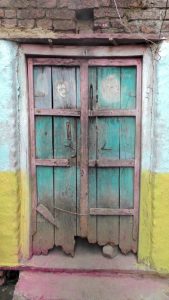
Photo 1: Old door
I have previously published a few articles on Jhiri. A public interest article is available here (McCartney, 2017a), while a linguistically-oriented article (McCartney, 2017b) and anthropologically-focused article (McCartney, 2017c) followed. I am also slowly making a low-budget documentary series. Here is the first episode, which documents the task of looking for the village.
I still remember the trepidation prior to going to the middle of Madhya Pradesh in late April. Before I ventured off into the unknown, I had spent most of February, March and April 2015 in the air-conditioned comfort of a friend’s apartment in the embassy district of Chanakyapuri, New Delhi, where I had been writing the final draft of my PhD thesis. As the temperature increased each day, my interest in leaving these comforts declined considerably. The comforts served as a retardant to literally getting off the couch and venture forth to do fieldwork.

Photo 2: Acharya Tiwari (right)
Initially, my biggest problem related to the ‘Sanskrit-speaking’ village of Jhiri was that the village was impossible to locate, which was basically due to limited and imprecise information. I decided, finally, just to go to Rajgarh district and see what might happen. I had been thinking about this village for a few years, since I came across it on my search for information about ‘Sanskrit-speaking’ villages. Initially, like many people, I wanted it to be true. I noticed that most of the websites, news articles and blog posts all seemed to be copying and pasting from each other. This made me even more curious about the veracity of the truth claims that ‘everyone speaks fluent Sanskrit’. Either people uncritically consume these stories as simply ‘true’, or, instead, they are dismissed. These wide-ranging opinions are fascinating. Why do people feel the need to believe these stories are true, or not?
There is an interdisciplinary blind spot related to spoken Sanskrit. Currently, I know of no other academic research into the ‘Sanskrit-speaking’ village phenomenon. Since Srinivas (1952, 1955, 1956, 1989), several works have been written on the topic of spoken Sanskrit. This includes: Nakamura (1973); Aralikatti (1989, 1991); Hock & Pandharipandhe (1976); Hock (1983, 1991, 1992); Pandharipande, (1991, 1992, 1995, 1996, 2006, 2008, 2010, 2013); and Hastings (2004, 2008). Probably, however, the most cogent overview of the success and failure of spoken Sanskrit is Deshpande (2011).
I find it interesting to explore, not only the politics involved in the reclamation of this variant of the classical language, but also its acquisition as a second language. This is directly involved in the political theology in which Sanskrit is embedded, which demands a lexical and grammatical purity for the moral, cultural and political reformation it is said, by ethno-nationalist Hindu supremacists, to foster. I tried to specifically collect linguistic data related to Sanskrit’s vitality in relation to how it survives within a complicated linguistic ecology.
Jhiri has only two Brahmins, out of a population of approximately 600, most of whom are from the Sondhiya caste. Therefore, how might the Brahminical Sanskrit language, in a rural village in India, evolve as a natural, as opposed to an artificial, language? What stages of imperfect learning, if left unchecked, might result in a creole-type hybrid between the first language(s) of the inhabitants and the revived Sanskrit?
I just turned up, unannounced at dusk, in Jhiri one day, and hoped that people would at least let me stay the night. Instead of staying only a few days, I ended up staying just over one month. My intention was to spend this month visiting as many ‘Sanskrit-speaking’ villages as possible in Madhya Pradesh, Rajasthan, Uttar Pradesh, Uttarakhand, and Haryana. But, I felt compelled to stay. The more I learnt about the community, the more fascinated I became. We became friends, almost instantly. It was hard to leave, in the end.
From Delhi, I took a train to Gwalior where I stayed with a Couchsurfing friend and his family. A few days later I took a bus to Guna, where I spent the night. The manager of the motel was convinced he knew where Jhiri was located. He organised a driver to escort me to Jhiri, which was apparently ‘only three hours away’. We literally drove around in circles that day, backwards and forwards, stopping at countless dusty intersections to ask for directions. It seemed many people had heard of this village (‘jo Sanskrit walleh gaon; that Sanskrit village’), but no one seemed to know exactly where it was. My experience with asking for directions in India is that no one generally wants to admit they don’t know. They would rather just tell you something.
My driver started to get annoyed. A few times he told me we should just turn around and return to Guna. At one point, quite late in the day, he explained that the bus in front of me was definitely going to Jhiri. So, as he implied, I could just get on that bus and he could go home. I asked him, ‘How do you know that bus goes to Jhiri when you don’t even know where Jhiri is?’ He kept driving in silence. Eventually we arrived. There was no sign that said, ‘Welcome to the Sanskrit-speaking village of Jhiri: An ancient world, India’s own Jurassic Park’.

Photo 3: Gheesha Lal (left) and two friends
Gheesha Lal, a tall, lanky, young man, approached. His beaming smile disarmed me, as he briskly walked over to the car and stuck his head inside the window. I spoke to him in Sanskrit. He, in turn, smiling, resplendent in his paan-stained singlet, responded in Sanskrit, which included an emphatic wiggle of his head. We became instant friends. Gheesha Lal would often take me on trips around the district on his motorbike. Having unloaded my bags from the car, Gheesha Lal led me up the main street to the home of the two Sanskrit teachers. Exhausted and relieved, I waited there and spoke Sanskrit with the husband and wife team.
In my third week in the village, during the evening celebrations of a wedding, I was asked by a couple of the villagers to speak with the Sanskrit teachers and convince them to start teaching Sanskrit again. I really wanted to stay out of this situation. It seemed not my place to intercede. But, following repeated requests, when the time felt right, I asked Acharya Tiwari why he and his wife no longer taught Sanskrit, and if they had any plans to restart the project. He replied, smiling as always, ‘Right now, we are just too busy with caring for our children, and I have my other teaching work outside the village. I don’t know if the Sanskrit will restart here, or not’.

Photo 4: Rooftop
During my stay, I slept on the roof of a three-storey building. Below, on the ground floor, the stable was full of buffalo. During the summer months, the coolest place to sleep was on the roof. It was even too hot for the mosquitoes this time of year. One did not need a blanket. To freshen up each morning, I would go down to the 44-gallon drum next to the toilet and buffalo, and, in the darkened corner on the ground floor, pour cool water over me to wash away the dust-encrusted sweat from my itchy body. The buffalo slowly warmed to me. There was not much light down on the ground floor, apart from what came through a skylight. The sound of buffalo chewing cud, and their primal grunts and huffs they made in that hot, dark room, haunt me a little bit.
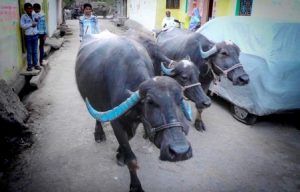
Photo 5: Buffalo roam
My first evening involved being taken around to meet the important people in the village. After dinner, we talked over a cup of sweetened tea. I asked the leaders of the village council for the opportunity to stay. We talked mostly in Sanskrit, yet sometimes we switched into Hindi. As I’m reasonably conversational in both languages, there was no problem in explaining my intentions, or being understood. I explained how I had heard about Jhiri in Australia through YouTube, and that I had come to India to see it for myself. I told them how I was a PhD student interested in documenting the revival of Sanskrit, and that it would be great to be able to collect data to make films and write papers. Essentially, there were no objections by the council to my project, as most were excited and interested. I was free to stay, as long as I wanted, and film-interview anyone who was interested in being involved.

Photo 6: Elders in the village
However, the problems I faced would reveal themselves soon enough. While some people were certainly not interested in being interviewed or filmed, and stayed inside their homes when I was present, I generally had more of an issue with keeping people out of the frame while recording, or not using up all my battery power and memory on taking a seemingly infinite number of selfies with everyone who requested them. Initially, some people were quite hesitant; however, the majority were not, and, over the weeks that I was there, the people (and the buffalo) became more familiar with me. This enabled at least some of the problems with trying to observe things in a natural state to dissipate, but not all of them. For instance, people would be speaking Malvi (the first language of the village and district) and Hindi with each other, but when I encountered a group of people, they would start speaking Sanskrit with me.
Jhiri does not have electricity or running water. The lack of lighting and generators made the soundscape of the village exceptionally tranquil. However, because there is only one working well in the main street, this sound created a rhythm throughout the day, as it was used non-stop, mostly by the young women and girls to collect water. This was an endless task, it seemed, which I have documented in this short film.
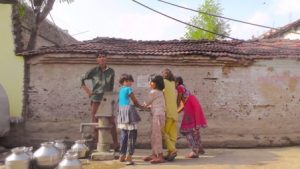
Photo 7: Water supply
The electricity story is more complex. The village council had refused, on principle, to pay their electricity bill. They refused because there were other villages close by that either did not pay a bill, or had a significantly reduced bill. This was due to nepotism and corruption, as family members worked for the electricity company. I did not become fully aware of this until it was time to recharge my laptop, video camera, phone, and voice recorder on about the third day.
This led to repeated trips to the next town where family members of people in Jhiri lived or worked. I started charging my equipment at a medical doctor’s surgery. It was down some steps off the main street. This basement location meant it was perceptibly cooler than up on the street, even without air-conditioning. However, on many occasions, I arrived to find the power already out, or, having just plugged my surge-protected power board in, the ‘electricity calī gayī (left)’. It was pointless asking the question, ‘When will the electricity come back on?’ as not even God knew the answer to that.
On several occasions, I was whisked into the back seat of a car, or onto the back of a motorbike, without any idea where I might be going. Generally, it involved visiting relatives in another district. Sometimes, this involved actual farm work, like in this film, where we went to a village about one hour away to collect grain.
These trips to related villages also helped me think about the viability of the Sanskrit reclamation project. Annually, young women leave their ancestral village to live with their in-laws. This constant exodus of Sanskrit speakers means that, unless these other villages also participate in the Sanskrit-speaking project, its future seems dim. The leaders in Jhiri are aware of this situation, but feel helpless to rectify the situation. This film shows some aspects of this festive wedding season in Jhiri.

Photo 8: Women and children travelling back from a wedding
Jhiri has 92 dwellings, of which only a handful have plumbing. Most of the villagers openly defecate at one of four spots on the edge of the village. I was oblivious to this situation, because the home I was staying in had a toilet. I wondered where, and why, people were walking to at different times of the day, with a little tub filled with water that returned empty. I thought, initially, that because of the heat, it was an attempt to stay hydrated. As I wandered around the village, I eventually came to the points on the edges of the village where most people went to answer nature’s call. Through my privileged perspective, I found it hard to understand why this village did not see this as a priority, as the World Health Organisation and the Indian government agree that open defecation is a serious health issue that not only costs billions of dollars, but also lives. While the village is self-reliant, when I asked about the lack of plumbing or better infrastructure for public health, the village council told me that they were waiting for Prime Minister Modi to come and build them toilets.
In Jhiri, except for one day of quintessential ‘loose motions’ caused by heat stress, I did not have any problems with my health. The water coming out of the aquifer was exceptionally clean and sweet. One day, however, the village was having a wedding party. I recall sitting there in line talking to a couple of the male visitors who had come with the groom from a village about 50 kilometers away. It was then that I noticed the plates we were eating from were full of graphic pictures of mouth cancer. It still strikes me as odd, that a festive occasion, such as a wedding, was in some way, potentially sullied by these confronting images. However, none of the people sitting nearby seemed to think it was odd.
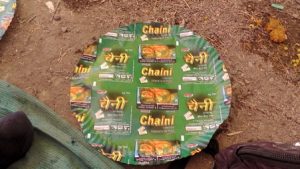
Photo 9: Cancer plate
But, my bowels were not good. I ate the food offered, all of which was fried and either salty or sweet. I politely excused myself to rush back to the privacy of the toilet amongst the buffalo. At least it was cool, dark, and quiet there. As I scuttled across the dry and dusty, windswept field, stopping repeatedly to remove clumps of hardened dirt from my sandals, I heard some of the wedding guests ask where I was going. The guy I had been sitting next to, without any thought for my privacy or dignity, simply declared to the 100 or so guests that: ‘He must go take a shit, he’s got loose motions’. The raucous laughter still haunts me a little. I am sure they still laugh while reminiscing about the foreigner scurrying across the field like a penguin.

Photo 10: Village portrait
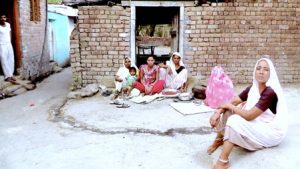
Photo 11: Women sorting food
I often think it would be great to spend a year in Jhiri and write a more extensive ethnography of the village. But, it would require many sacrifices, particularly on a personal level. Personally, I do not think that it is feasible, even if part of me would like to do it. The main reason, however, is that there were hardly any people who spoke Sanskrit. Even though the media continue to produce stories that the entire village speaks Sanskrit. It is my impression that, of the 600 residents of the village, only about ten spoke Sanskrit at a comfortably conversational level, which was closer to the perceived purity of the Classical register, was mostly free of grammatical errors, and had minimal substrate interference from Malvi and Hindi. We were able to converse, indefinitely, with relative ease, on a variety of topics, using different tenses, cases and moods, without having to switch to Hindi. Beyond this, perhaps another 20 people tried to speak a disjointed variant that occurred through the prompting of elders to perform some standard sentences, which, often only got as far as, for example, ‘Hello, my name is Akhilesh. How are you?’ Beyond this, the rest of the villagers were limited to ‘Namo namah’, which means ‘Hello’.

Photo 12: Two boys by a door
Also, even with this lack of speakers, I was repeatedly told that people were speaking more Sanskrit because I was there, which made me wonder, How little Sanskrit is spoken without an outsider’s influence? It seems that, based on the small amount of Sanskrit spoken in my presence, then, the answer might be that there would be not much, if any, spoken on a regular basis. The Sanskrit adoption project in Jhiri seems to have reached its endpoint, even if the villagers want to revive their own ‘revival’ project. I am still in semi-regular contact with some of the villagers through Facebook and Whatsapp. This has been an interesting way to continue to collect data in informal registers of Sanskrit as we continue, for the most part, to converse in Sanskrit.

Photo 13: Preparing lunch

Photo 14: Lunch prepared
Now that I am engaged in a different research project, my attention has turned towards learning Japanese, and trying to learn more about the spiritual marketplace in Japan. I do hope, though, to continue to journey into Sanskrit Land, as the Sanskrit language and its imaginative consumption are indelibly linked to the global consumption of yoga-inflected lifestyles. It still fascinates me when I hear a consumer of global yoga assert, ‘Have you heard about that village in India where everyone speaks Sanskrit?’ I can only respond, with a glint of a smile, ‘Go on, please tell me’.
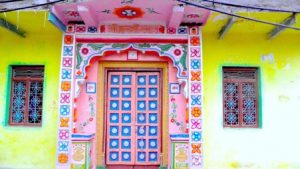
Photo 15: Ornate door
References
Aralikatti, R. N. 1989. Spoken Sanskrit in India: A Study of Sentence Patterns. Tirupati: Kendriya Sanskrit Vidyapeetha.
Aralikatti, R.N. 1991. A note on the word order in modern spoken Sanskrit and some positive constraints. In H.H. Hock, ed., Studies in Sanskrit Syntax, 13-17. Delhi: Motilal Banarsidas.
Deshpande, M. M. 2011. Efforts to vernacularize Sanskrit: Degree of success and failure. In Joshua Fishman, ed., Handbook of language and ethnic identity: The success-failure continuum in language and ethnic identity efforts, 218-19. Oxford: Oxford University Press.
Hastings, A. M. 2004. Past perfect, future perfect: Sanskrit revival and the Hindu nation in contemporary India. PhD. Chicago.
Hastings, A. M. 2008. Licked by the mother tongue: Imagining everyday Sanskrit at the home and in the world. Journal of Linguistic Anthropology 18, 1:24-45.
Hock, H. H. 1983. Language Death Phenomena in Sanskrit: Grammatical evidence for attrition in contemporary spoken Sanskrit. Studies in the Linguistic Sciences 13, 2:21-35.
Hock, H. H. 1991. Review: R. N. Aralikatti: Spoken Sanskrit in India: A study of sentence patterns. Studies in the Linguistic Sciences 21, 1:161-65.
Hock, H. H. 1992. A note on English and modern Sanskrit. World Englishes 11, ⅔:163-71.
Hock, H. H., and R. Pandaripande. 1976. The sociolinguistics position of Sanskrit in pre-Muslim South Asia. Studies in Language Learning 1, 2:106-38.
Deshpande, M. M. 2011. Efforts to Vernacularize Sanskrit: Degree of Success and Failure. In Joshua Fishman, ed., Handbook of Language and Ethnic Identity: The Success-Failure Continuum in Language and Ethnic Identity Efforts, 218-19. Oxford: Oxford University Press.
McCartney, Patrick. 2017a. Imagining Sanskrit Land. UTNE Reader Fall:35-42.
McCartney, Patrick. 2017b. Jhirī: A ‘Sanskrit-speaking’ village in Madhya Pradesh. Journal of South Asian Languages and Linguistics 4, 2:167-209.
McCartney, Patrick. 2017c. Speaking of the Little Traditions: Agency and Imposition in ‘Sanskrit-Speaking’ Villages in North India. In Lucas den Boer and Daniele Cuneo, eds., Puṣpikā: Tracing Ancient India Through Text and Traditions, 62-88. Philadelphia: Oxbow Books.
Nakamura, Hajime. 1973. A companion to contemporary Sanskrit. Delhi: Motilal Banarsidas.
Pandharipande, Rajeshwari. 1991. The perfected language. English Today 7, 2:7-10.
Pandharipande, Rajeshwari. 1992. Language shift in India: Issues and implications. In W. Fase, K. Jaspaert and S. Kroon, eds., Maintenance and loss of minority languages, 253-276. Amsterdam: John Benjamins.
Pandharipande, Rajeshwari. 1995. Decoding meaning in a second Language. In V. Gambhir, ed., The Teaching and Acquisition of South Asian Languages, 39-56. Philadelphia: University of Pennsylvania.
Pandharipande, Rajeshwari. 1996. Language shift with maintenance: The case of Sanskrit in India. In Shivendra K. Verma and Dilop Singh, eds., Perspectives on Language in Society: Papers in memory of Prof. Srivastava, 183-205. Delhi: Kalinga.
Pandharipande, Rajeshwari. 2006. Ideology, authority, and language choice: Language of religion in South Asia. In Tope Omoniyi and Joshua A. Fishman, eds., Explorations in the sociology of language and religion, 141-64. Amsterdam: John Benjamins Publishing Company.
Pandharipande, Rajeshwari. 2008. Language of Religion. In Braj B. Kachru, Yamuna Kachru and S. N. Sridhar, eds., Language of South Asia, 407-25. Cambridge: Cambridge University Press.
Pandharipande, Rajeshwari. 2010. Authenticating a Tradition in Transition: Language of Hinduism in the US. In Tope Omoniyi, ed., The Sociology of Language and Religion: Change, Conflict and Accommodation, 58-83. New York: Palgrave Macmillan.
Pandharipande, Rajeshwari. 2013. The language of Hinduism in the US diaspora. World Englishes 32, 3:417-28.
Srinivas, M. N. 1952. Religion and Society Among the Coorgs of South India. Oxford: Clarendon Press.
Srinivas, M. N. 1955. The Social System of a Mysore Village. In McKim Marriot, ed., Village India: Studies in the Little Community, 1-35. Chicago: University of Chicago Press.
Srinivas, M. N. 1956. A Note on Sanskritization and Westernization. The Far Eastern Quarterly 15, 4:481-96.
Srinivas, M. N. 1989. The Cohesive Role of Sanskritization and Other Essays. Delhi: Oxford University Press.






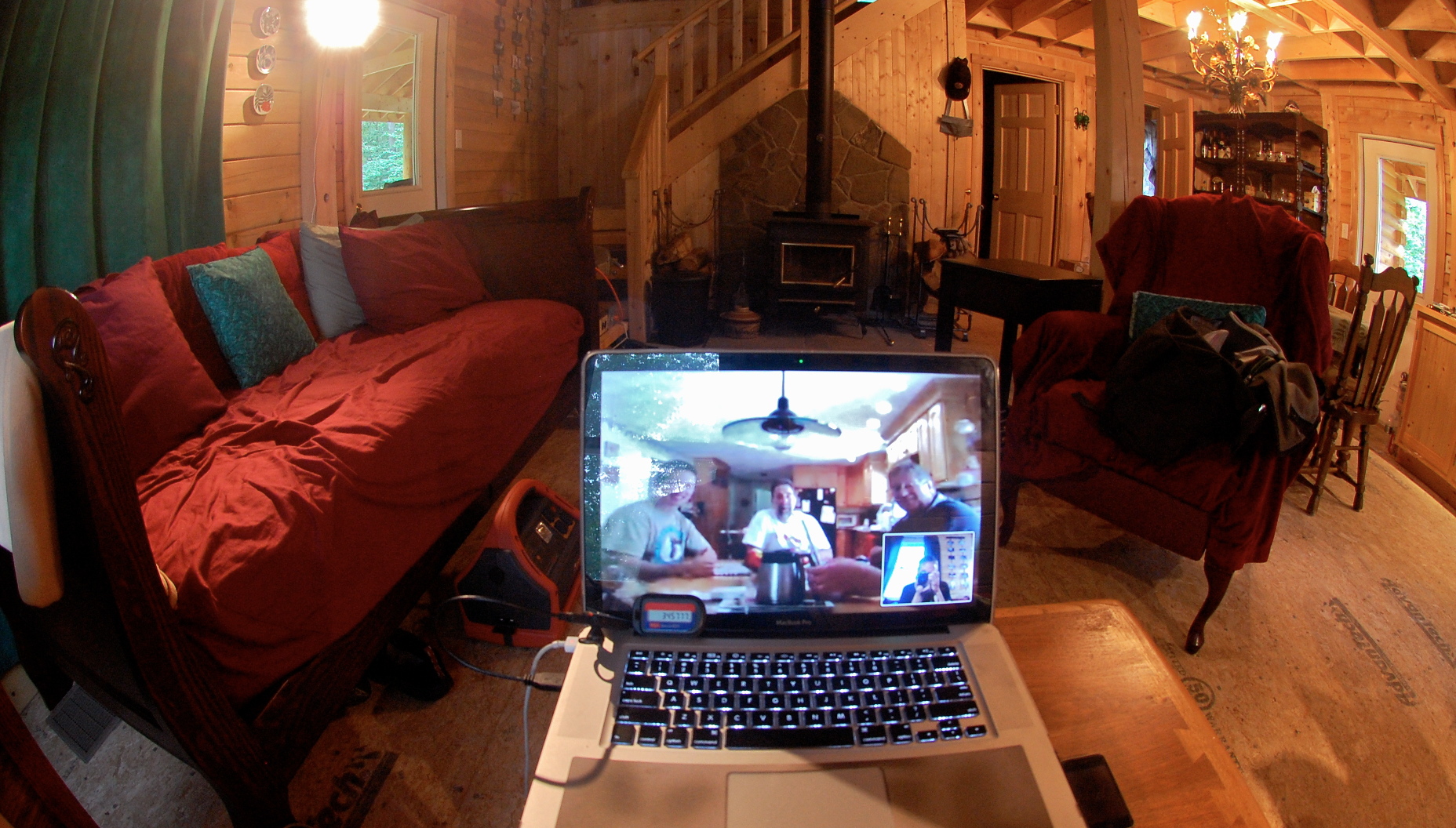
Hi all, here every one is sharing these kinds of familiarity,
therefore it’s good to read this website, and I used to go to see this web site daily.
I have read several excellent stuff here. Definitely value bookmarking for revisiting. I surprise how so much attempt you put to create this kind of fantastic informative site.
Gerektiğinde gecelik görüşebilen sizin isteğinize göre saatlik ya da tek seans şeklinde de randevular veren esma yada sarışın güzeller kalite standartlarını çok yüksek tutuyor sağlıklı ilişkileri ile sizi güvenilir koşullarda misafir ederek mutlu ediyor. Elit kadınlara güvenin onlarla beraber harika ucuz girls ilişkileri yaşamak için harekete geçin. Enerji dolu seks ilişkileri paylaşan dinamik üniversiteli genç kızlarda Kayseri escort platformu içerisinde sizin için üyelik oluşturdu. Eve gelen ve otele gelen seçenekleri ile bu kızlardan randevu alabilir sınırsız seks ayrıcalığını onlarla beraber yaşayabilir hatta anal ve cimcif ilişkilerde de buluşabilirsiniz.
Yün cami halısı desenlerinde kullanılan yün, aşınmaya karşı dayanıklı olduğu için uzun yıllar boyunca verimli ve sağlıklı bir şekilde kullanılabilir.
Thank you for great content. Betroad , Betroad Giri� , Betroad G�ncel Giri� . https://betroadgiris.net/
Türkiye’nin en güçlü disk yapısını kullanmamızdaki ana sebep hızlı ve sorunsuz bir sanal sunucu hizmeti almanıza olanak sağlamak
Nice article inspiring thanks. Casino , Casino Siteleri , Casino Sitesi , Güvenilir Casino Siteleri , Casino Siteleri
hosting,alan adı, dedicated,sanal sunucu performans, hız, kalite olarak en iyi sağlayan firmayız.
That is the suitable weblog for anybody who desires to seek out out about this topic. You notice a lot its virtually laborious to argue with you (not that I truly would need…HaHa). You undoubtedly put a brand new spin on a topic thats been written about for years. Nice stuff, simply nice!
Betroad para çekme hızı ile şaşırtan ve kendine hayran bırakan bir bahis sitesidir. Günün her saatinde hiçbir şekilde ara vermeden para çekim işlemlerini …
Download free mod apk files.
Psikiyatristler; gerekli durumlarda, ihtiyaç durumuna göre ilaç ve psikoterapi veya yalnızca psikoterapi uygulayabilen hekimlerdir.
Nosa Game Studio tarafından oluşturulan Starrow, mobil uyumlu tüm cihazlar için çok ufak ve eğitici basit oyundur. Gezegenlere lazer ışınları fırlatarak
Thank you for great information. Hello Administ .
Thank you great post. Hello Administ .
Sürekli gelişen teknolojiyi yakından takip ederek, en iyi ürün ve hizmet garantisi sunuyoruz.
Hello, Neat post. There’s a problem with your web site in web explorer, might check thisK IE still is the market leader and a large section of folks will pass over your excellent writing because of this problem.
you have a great blog here! would you like to make some invite posts on my blog?
I am continuously searching online for tips that can benefit me. Thx!
NOKIAN.COM.RU
https://nokian.com.ru/ – NOKIAN.COM.RU
90 (236) 462 33 97 – 98
Cami Halısı Çeşitleri
cami avizesi
Camiler İslam kültüründe oldukça önemli mimari yapılardır. Camiler binlerce insanı bir araya getirirken, İslam mimarı ve motiflerini de içinde barındıran kültürel bir mirastır. Mimari yapısı, motifleri ve daha birçok özelliği ile göz alıcı güzelliğe sahip olan camilerde kullanılan halılar da dikkat çekici detaylar arasında yer alır. Cami halısı desenleri çeşitli yapılara sahiptir. Bunlar; saflı cami halısı, seccadeli cami halısı, göbekli cami halısı gibi modellerdir. Cami halısı modelleri üretiminde kullanılan hammadde ve desen açısından birbirinden farklılık gösterir. Bu modeller arasında en çok tercih edilen modeller arasında saflı cami halısı ve göbekli cami halısı modelleri bulunur. Saflı cami halısı modeli, düzenli ve eşit aralıkları ile saflara ayrılarak, ibadet eden kişilerin huzurlu bir ortam içerisinde ibadetlerini gerçekleştirmelerine yardımcı olur. Düzenli ve hijyenik bir yapıya sahip olan saflı cami halısı, desen ve motifleri ile estetik bir görünüm sağlar ve ibadet eden kişilerin huzurlu bir ibadet ortamında olmalarına yardımcı olur. Akrilik cami halıları ise fiziksel dış etkenlere karşı kuvvetli olmasıyla dikkat çeker ve bu özelliği sayesinde uzun süreli kullanım imkanı sağlar. Keçelenmenin önüne geçen malzemesi ile halının aşınması ya da iz tutması gibi durumların önüne geçer aynı zamanda akrilik cami halıları rutubet ve küf tutmayan özellikleri ile dört mevsim boyunca rahatlıkla kullanılabilir. Göbekli cami halısı modeli, adından da anlaşıldığı üzere halının orta kısmında büyük bir desenin yer aldığı halı modelidir. Ülkemizde yer alan camilerde sıklıkla tercih edilen bu halı modeli, ateşe karşı dayanıklıdır ve ısı yalıtımı, ses akustiği sağlar.
Özellikleri Su ile temizlenebilme özelliğine sahiptir. Kokusuzdur. Çabuk kuruma özelliği ile kullanışlıdır. ve temizlenmesi basittir. Temizlenmesi basittir. Çok çeşitli renk alternatifleri, desenleri bulunur. Yün Cami Halısı Geleneksel Türk motiflerine bağlı kalınarak üretilen saf yün cami halısını çok farklı ve özel bir kalite ile üretmektedir. Yün cami halısı, doğal bir ham madde olan yünden üretildiğinden insan sağlığına ve çevreye hiçbir zararı yoktur. Yün cami halı desenleri, kışın sıcak tutar ve yazın terletmez. Havadaki nem kuruyunca üzerindeki nemi geri verir. Böylece serili bulunduğu ortamda doğal nem ayarı yapar. Yün cami halısı desenlerinde kullanılan yün, aşınmaya karşı dayanıklı olduğu için uzun yıllar boyunca verimli ve sağlıklı bir şekilde kullanılabilir. Yün cami halıları ayak ve diz kısımlarının uyguladığı baskılara dayanıklıdır. Herhangi bir görüntü bozukluğu yaşanmaz. Yün Cami Halı desenleri tarihi camilerin dokusu ve motiflerine uygun olarak özel olarak tasarlanıp. 0 Yerli Üretimdir.
Your type is absolutely one of a kind compared to Other individuals I’ve read stuff from. Lots of thanks for publishing If you have the opportunity, Guess I’ll just e-book mark this web site.
I truly adore your internet site.. Pleasant hues & concept. Did you make this Site you? You should reply back again as I’m planning to create my own personalized Web page and would enjoy to discover in which you obtained this from or what the topic is named. Thanks!
To Top
Kalite Belgelerimiz
0
Samur Cami Halıları Samur olarak 40 Yıllıa yakın bilgi birikimini cami halılarına yansıtıyoruz. Samur Cami Halıları; tüy dökmez, alev almaz, antistatik ve antibakteriyeldir. Samur Cami Halıları 10 Yıl Garantilidir. Özel siparis kapsamında halısı üretilen bazı cami projelerimize ve Saflı ve Mihraplı Samur Cami Halıları ürünlerimize gözatabilirsiniz.
Devamını OkuDevamını Oku celebizadeeski Çelebizade Halı ürettiği kaliteli, uzun ömürlü, sağlam, hepsi birbirinden güzel desen ve renklerdeki, diz izi yapmayan, tüy ya da toz bırakmayan, anti-statik, anti-bakteriyel ve insan sağlığına uyumlu halılarıyla ülkemizde cami halısı ve yurt halısı sektöründe sıklıkla tercih edilen bir markadır. Çelebizade Halı’da müşteri memnuniyeti ve güvenine her şeyden çok önem verilmektedir. Bu sebeple tüm halılarımız halının bir kere alınıp, yıllarca kullanılan bir eşya olduğunun bilinciyle kaliteli malzemeden ve uzun yıllar dayanıklılığını koruyacak şekilde üretilmektedir.Ayrıca “Sonsuz Desen ve Renk” ilkesiyle, birbirinden güzel cami halısı desenleri, yurt halısı desenleri, sınır tanımayan renk seçenekleri ile cami halısı ve yurt halısı sektörlerinde çığır açmıştır. Üstelik yurt içi pazarında oldukça ilgi gören Çelebizade Halı, ürettiği kaliteli, uzun ömürlü, göz dolduran,farklı desen ve renk seçeneklerine sahip cami halılarını yurt dışı pazarına da sunmuş, burada da oldukça yoğun bir ilgiyle karşılaşmıştır.
Çim Halı 7 mm
bunadisisj nsjjsjsisjsmizjzjjzjzz zumzsert
I was recommended this website through my cousin. I am now not certain whether this put up is written by way of him as no one else realize such targeted approximately my difficulty. You’re amazing! Thanks!
bunadisisj nsjjsjsisjsmizjzjjzjzz zumzsert
I really love to read such an excellent article. Helpful article. Hello Administ . child porn 現場兒童色情片 活婴儿色情片 儿童色情 児童ポルノ 兒童色情 国产线播放免费人成视频播放 国产线播放免费人成视频播放
WOW just what I was searching for. Came here by searching for website
Thank you for great content. Hello Administ . casibom
Finding best Immigration Consultant in Canada? So we will help to apply Student, Work, Immigrant, sponsorship, visitor visa in Canada. Apply Now!
I always was concerned in this subject and still am, thankyou for posting.
In the great design of things you actually secure an A for effort. Exactly where you confused me was on all the details. As as the maxim goes, details make or break the argument.. And it couldn’t be more accurate at this point. Having said that, permit me reveal to you precisely what did do the job. Your writing is actually rather persuasive and that is most likely the reason why I am making an effort in order to opine. I do not really make it a regular habit of doing that. Next, despite the fact that I can notice the leaps in reason you make, I am definitely not certain of how you seem to unite the details which in turn help to make the actual conclusion. For the moment I shall subscribe to your position but wish in the future you link the dots better.
Magnificent web site. Lots of useful information here.
I am sending it to several buddies ans additionally sharing in delicious.
And obviously, thank you for your sweat!
Also visit my blog tracfone special coupon 2022
Thanks for another excellent post. Where else may anybody get that kind of info in such a perfect manner of writing? I have a presentation subsequent week, and I am at the look for such info.
It’s a pity you don’t have a donate button! I’d certainly
donate to this superb blog! I suppose for now i’ll settle for bookmarking and adding your RSS feed to my Google account.
I look forward to new updates and will share this website with my Facebook
group. Chat soon!
Also visit my website: tracfone coupon
An impressive share! I have just forwarded this onto a colleague who was undertaking somewhat study on this. And he in fact acquired me lunch due to The reality that I stumbled upon it for him… lol. So make it possible for me to reword this…. Thank YOU for that food!! But yeah, many thanks for shelling out a while to take a look at this topic in this article on your internet site.
I really appreciate your site.. Nice shades & theme. Did you make this Web-site your self? Be sure to reply back as I’m planning to build my very own private Web page and would like to learn in which you obtained this from or exactly what the topic is named. Many thanks!
Hello globalethnographic.com Admin, exact here: Link Text
Dear globalethnographic.com administrator, You always provide valuable feedback and suggestions.
Hello globalethnographic.com admin, You always provide great examples and real-world applications, thank you for your valuable contributions.
Hello globalethnographic.com webmaster, Your posts are always interesting.
Hi globalethnographic.com administrator, You always provide useful tips and best practices.
To the globalethnographic.com admin, You always provide great examples and real-world applications.
Hello globalethnographic.com webmaster, Your posts are always well-supported by facts and figures.
Dear globalethnographic.com admin, Your posts are always a great source of information.
To the globalethnographic.com administrator, You always provide in-depth analysis and understanding.
Hello globalethnographic.com webmaster, Keep up the good work!
Hello globalethnographic.com administrator, Thanks for the well written post!
Dear globalethnographic.com admin, Your posts are always well structured and easy to follow.
Hello globalethnographic.com webmaster, Your posts are always well-cited and reliable.
To the globalethnographic.com admin, Thanks for sharing your thoughts!
Hi globalethnographic.com owner, You always provide valuable information.
Dear globalethnographic.com webmaster, You always provide clear explanations and step-by-step instructions.
To the globalethnographic.com owner, Thanks for sharing your thoughts!
Dear globalethnographic.com admin, Thanks for the great post!
Dear globalethnographic.com owner, Keep it up!
Hello globalethnographic.com administrator, Your posts are always insightful and valuable.
Hello globalethnographic.com webmaster, Your posts are always well-delivered and engaging.
Hello globalethnographic.com administrator, Your posts are always a great source of knowledge.
Hi globalethnographic.com administrator, You always provide helpful information.
Hi globalethnographic.com webmaster, You always provide valuable information.
Dear globalethnographic.com webmaster, Great job!
Hello globalethnographic.com owner, Your posts are always well-written and engaging.
Hi globalethnographic.com admin, You always provide useful tips and best practices.
Dear globalethnographic.com webmaster, You always provide clear explanations and step-by-step instructions.
To the globalethnographic.com administrator, Your posts are always well written.
Dear globalethnographic.com administrator, You always provide useful links and resources.
Dear globalethnographic.com owner, Your posts are always informative and well-explained.
Hello globalethnographic.com administrator, Your posts are always well-structured and logical.
Hi globalethnographic.com admin, Thanks for the well-researched post!
To the globalethnographic.com owner, You always provide in-depth analysis and understanding.
Dear globalethnographic.com webmaster, Keep sharing your knowledge!
To the globalethnographic.com administrator, Your posts are always well-written and easy to understand.
Dear globalethnographic.com admin, Your posts are always a great source of knowledge.
Hi globalethnographic.com webmaster, Great post!
To the globalethnographic.com owner, You always provide practical solutions and recommendations.
To the globalethnographic.com owner, Thanks for the in-depth post!
Dear globalethnographic.com owner, Your posts are always well-referenced and credible.
To the globalethnographic.com administrator, You always provide practical solutions and recommendations.
To the globalethnographic.com webmaster, Nice post!
Hello globalethnographic.com webmaster, Your posts are always well-referenced and credible.
Dear globalethnographic.com owner, Your posts are always well-written and easy to understand.
Hello globalethnographic.com admin, Excellent work!
toradol 15 mg
inderal buy online uk
viagra buy online
where to buy avodart online
iv prednisone
usa pharmacy
suhagra 100 buy online
buy propecia online no rx
100 mg lexapro
To the globalethnographic.com administrator, Your posts are always informative and well-explained.
To the globalethnographic.com webmaster, Your posts are always well organized and easy to understand.
I frequently write on blogs, and I just wanted to say how much I enjoy reading your content.
Hello globalethnographic.com webmaster, Thanks for the in-depth post!
I am going to save your website to my bookmarks, and I will be checking here frequently for brand spanking new material.
Hi globalethnographic.com webmaster, Good to see your posts!
Hi globalethnographic.com admin, Thanks for sharing your thoughts!
There is definately a lot to find out about this subject. I like all the points you made
Hellooooooooooooo
I highly recommend this relationship Doctor Mr Buckler
You can win your Ex lover back in 48 hours just like me.
Very effective …
For fast and reliable solution.
Get boyfriend back after break up.
Get girlfriend back after break up.
Get Gay partner back.
Get Lesbian partner back.
Make Your Husband/Wife love you Forever.
Stop Having Bad Dreams.
Make Women/Men To Run After You.
Stop Divorce from happening.
Divorce Your Husband/Wife.
Make Partner marry you.
Win Court Case/Law suit.
Get pregnant.
Luck To Win A Lottery.
Stop Marriage/Relationship from Breaking Apart.
Robinsonbuckler11@gmail. com………
Hellooooooooooooo
I highly recommend this relationship Doctor Mr Buckler
You can win your Ex lover back in 48 hours just like me.
Very effective …
For fast and reliable solution.
Get boyfriend back after break up.
Get girlfriend back after break up.
Get Gay partner back.
Get Lesbian partner back.
Make Your Husband/Wife love you Forever.
Stop Having Bad Dreams.
Make Women/Men To Run After You.
Stop Divorce from happening.
Divorce Your Husband/Wife.
Make Partner marry you.
Win Court Case/Law suit.
Get pregnant.
Luck To Win A Lottery.
Stop Marriage/Relationship from Breaking Apart.
Robinsonbuckler11 @ gmail……com………
Helloo..
I highly recommend Mr Buckler,
Fix broken Relationship/Marriage..
Win back your Ex-Lover
Thank you so so much
????????????????????????????????????????????
Thanks million????????????
Reach.. R.buckler 11 (((gmail…… com)))
Helloo..
I highly recommend Mr Buckler,
Fix broken Relationship/Marriage..
Win back your Ex-Lover
Thank you so so much
????????????????????????????????????????????
Thanks million????????????
Reach.. R.buckler11 (((@gmail.com)))
Helloo..
I highly recommend Mr Buckler,
Fix broken Relationship/Marriage..
Win back your Ex-Lover
Thank you so so much
????????????????????????????????????????????
Thanks million????????????
Reach.. R.buckler1 1 (((gmail…… com )))
I highly recommend Mr Buckler,
Fix broken Relationship/Marriage..
Win back your Ex-Lover
Thank you so so much
????????????????????????????????????????????
Thanks million????????????
Reach.. R.buckler11 (((@gmail…… com)))
Dear globalethnographic.com owner, Nice post!
Hi globalethnographic.com webmaster, Your posts are always informative and up-to-date.
Hi globalethnographic.com webmaster, Your posts are always a great read.
To the globalethnographic.com owner, You always provide great examples and real-world applications, thank you for your valuable contributions.
Dear globalethnographic.com administrator, Thanks for the well-organized and comprehensive post!
Hello, I do believe your website could possibly be having browser compatibility problems.
Whenever I take a look at your web site in Safari, it
looks fine however, when opening in Internet Explorer, it’s got some overlapping issues.
I merely wanted to provide you with a quick heads up!
Apart from that, wonderful site!
Wow, this blogger is seriously impressive!
I appreciate your creativity and the effort you put into every post. Keep up the great work!
Hello globalethnographic.com owner, Your posts are always well organized and easy to understand.
Hi globalethnographic.com admin, Your posts are always a great source of knowledge.
Hi globalethnographic.com webmaster, Your posts are always informative and well-explained.
To the globalethnographic.com administrator, Thanks for the informative and well-written post!
I just like the valuable info you provide on your articles.
I will bookmark your weblog and take a look at again here frequently.
I am moderately certain I will be informed a lot of new stuff proper here!
Good luck for the next!
To the globalethnographic.com admin, Your posts are always well presented.
You can certainly see your enthusiasm in the work you write.
The sector hopes for more passionate writers like you who are not
afraid to say how they believe. All the time follow your heart.
Thanks for finally talking about > Reflections on the
Imagining Sanskrit Land Project – Global Ethnographic < Liked it!
Hi there, tidy web page you’ve gotten right now. retin-a disponible sans ordonnance en Espagne
It covers a wide range of subtopics, providing a comprehensive overview of the subject. 바카라사이트
Heya i’m for the primary time here. I came across this board and I in finding It truly useful & it helped me out much.
I’m hoping to give something back and aid others like you aided me.
Useful information. Fortunate me I found your website by
chance, and I’m surprised why this accident did not took place earlier!
I bookmarked it.
fun88 ทางเข าเด ทท อป นับว่าเป็นสถานที่ที่เหมาะสำหรับผู้ที่หลงใหลในการเดิมพันกีฬา คุณสามารถเลือกแทงบอลหรือกีฬาอื่นๆ ได้ตามความชื่นชอบ นอกจากนี้ ยังมีเกมคาสิโนสดที่น่าตื่นเต้นรอคุณอยู่ เช่น บาคาร่า รูเล็ต และเกมสล็อตที่น่าตื่นเต้.นมากมาย
Thanks for the good writeup. It in truth was once a entertainment account it.
Glance advanced to far added agreeable from you! By the
way, how can we be in contact?
Dear globalethnographic.com owner, You always provide valuable information.
Hello globalethnographic.com administrator, You always provide useful links and resources.
расклад на сегодня таро 20 августа кто по знаку зодиака 1996 год крысы водолей
12 июля 2024 лунный день, 11 августа 2024 лунный день мэри грир
королевский двор таро читать
онлайн, мэри грир 21 способ толкования карт таро скачать
Hello, I am your admin. I would be very happy if you publish this article.
In these days of austerity along with relative stress about getting debt, many individuals balk resistant to the idea of using a credit card in order to make acquisition of merchandise or perhaps pay for any occasion, preferring, instead just to rely on the tried and trusted method of making transaction – raw cash. However, if you have the cash there to make the purchase in full, then, paradoxically, that’s the best time just to be able to use the credit card for several motives.
Thank you great posting about essential oil. Hello Administ . Seo Paketi Skype: By_uMuT@KRaLBenim.Com -_- live:by_umut
Hello, I am your admin. I would be very happy if you publish this article.
Hello, I am your admin. I would be very happy if you publish this article.
Hello, I am your admin. I would be very happy if you publish this article.
Hello, I am your admin. I would be very happy if you publish this article.
Hello, I am your admin. I would be very happy if you publish this article.
Hello, I am your admin. I would be very happy if you publish this article.
Hello, I am your admin. I would be very happy if you publish this article.
Hello, I am your admin. I would be very happy if you publish this article.
Hello, I am your admin. I would be very happy if you publish this article.
Hello, I am your admin. I would be very happy if you publish this article.
Hello, I am your admin. I would be very happy if you publish this article.
Hello, I am your admin. I would be very happy if you publish this article.
Hello, I am your admin. I would be very happy if you publish this article.
Hello, I am your admin. I would be very happy if you publish this article.
Hello, I am your admin. I would be very happy if you publish this article.
Hello, I am your admin. I would be very happy if you publish this article.
Hello, I am your admin. I would be very happy if you publish this article.
Hello, I am your admin. I would be very happy if you publish this article.
Hello, I am your admin. I would be very happy if you publish this article.
Hi globalethnographic.com administrator, You always provide key takeaways and summaries.
Hello, I am your admin. I would be very happy if you publish this article.
Hello, I am your admin. I would be very happy if you publish this article.
Hello, I am your admin. I would be very happy if you publish this article.
Hello, I am your admin. I would be very happy if you publish this article.
Hello, I am your admin. I would be very happy if you publish this article.
Thank you for great content. Hello Administ. Seo Paketi Skype: By_uMuT@KRaLBenim.Com -_- live:by_umut
Hello, I am your admin. I would be very happy if you publish this article.
Hello, I am your admin. I would be very happy if you publish this article.
Hello, I am your admin. I would be very happy if you publish this article.
Hello, I am your admin. I would be very happy if you publish this article.
Hello, I am your admin. I would be very happy if you publish this article.
Hello, I am your admin. I would be very happy if you publish this article.
Hello, I am your admin. I would be very happy if you publish this article.
Hello, I am your admin. I would be very happy if you publish this article.
Hello, I am your admin. I would be very happy if you publish this article.
Hello, I am your admin. I would be very happy if you publish this article.
Hello, I am your admin. I would be very happy if you publish this article.
Hello, I am your admin. I would be very happy if you publish this article.
Hello, I am your admin. I would be very happy if you publish this article.
Hello, I am your admin. I would be very happy if you publish this article.
http://stateholidays.in/en/tour/kashmir-tour-with-gulmarg/
Hello, I am your admin. I would be very happy if you publish this article.
Hello, I am your admin. I would be very happy if you publish this article.
Hello, I am your admin. I would be very happy if you publish this article.
Hello, I am your admin. I would be very happy if you publish this article.
Hello, I am your admin. I would be very happy if you publish this article.
Hello, I am your admin. I would be very happy if you publish this article.
Hello, I am your admin. I would be very happy if you publish this article.
Hello, I am your admin. I would be very happy if you publish this article.
Hello, I am your admin. I would be very happy if you publish this article.
Hello, I am your admin. I would be very happy if you publish this article.
Hello, I am your admin. I would be very happy if you publish this article.
Hello, I am your admin. I would be very happy if you publish this article.
Hello, I am your admin. I would be very happy if you publish this article.
Hello, I am your admin. I would be very happy if you publish this article.
Hello, I am your admin. I would be very happy if you publish this article.
Hello, I am your admin. I would be very happy if you publish this article.
Hello, I am your admin. I would be very happy if you publish this article.
Hello, I am your admin. I would be very happy if you publish this article.
Hello, I am your admin. I would be very happy if you publish this article.
Hello, I am your admin. I would be very happy if you publish this article.
Hello, I am your admin. I would be very happy if you publish this article.
Hi, just required you to know I he added your site to my Google bookmarks due to your layout. But seriously, I believe your internet site has 1 in the freshest theme I??ve came across.Seo Paketi Skype: By_uMuT@KRaLBenim.Com -_- live:by_umut
Hello, I am your admin. I would be very happy if you publish this article.
Hello, I am your admin. I would be very happy if you publish this article.
Hello, I am your admin. I would be very happy if you publish this article.
Hello, I am your admin. I would be very happy if you publish this article.
Hello, I am your admin. I would be very happy if you publish this article.
Hello, I am your admin. I would be very happy if you publish this article.
I will right away snatch your rss feed as I can’t to find your email subscription link or newsletter service. Do you have any? Kindly permit me know so that I may subscribe. Thanks.
Hello, I am your admin. I would be very happy if you publish this article.
Nice article inspiring thanks. Hello Administ . Seo Paketi Skype: By_uMuT@KRaLBenim.Com -_- live:by_umut
Hello, I am your admin. I would be very happy if you publish this article.
Hello, I am your admin. I would be very happy if you publish this article.
Hello, I am your admin. I would be very happy if you publish this article.
Thank you for great article. Hello Administ .Seo Paketi Skype: By_uMuT@KRaLBenim.Com -_- live:by_umut
Hello, I am your admin. I would be very happy if you publish this article.
Hello, I am your admin. I would be very happy if you publish this article.
Hello, I am your admin. I would be very happy if you publish this article.
Hello, I am your admin. I would be very happy if you publish this article.
Wild Walker Slot has 5 reels and 25 pay lines. It’s based on a world where a lab investigating viruses has accidentally released a virus that causes humans to become flesh-eating. It’s closely linked to the Walking Dead – you get a chance to save the world and end a zombie apocalypse by playing the Wild Walker Slot. It’s got high volatility (win a win ceiling of 4900x your bet), matching the theme, and has high-quality artwork and animation. The main feature of Frankenstein Slots is its free spins, during which players can win up to 5x. The max win on each spin of this online Halloween slot machine is 875x the original stake and can be won if all 3 wild symbols appear. Frankenstein’s RTP is 96.70%. Another way of celebrating Halloween is by visiting a haunted theme park surrounded by ghosts. If that’s the sort of thing that interests you, then Stakelogic’s Devil’s Trap could be the perfect slot for you to play Halloween 2022.
https://dsred.com/home.php?mod=space&uid=3862332
Now that you know what the Quickspin slot games look like in demo format, perhaps you’d like to experience them for real money. If this is true for you, then you will need to visit and register for an account at a trustworthy and fair online casino site. To ensure that you’re experiencing this, we have a selection of Quickspin casinos that we can recommend to you. Through joining one of these, you will get to play the slots in a safe environment and benefit from fantastic promotions. The betting range is flexible enough to fit into any budget, be it big or small. Of course, the betting limits may vary depending on which casino you are playing at but generally betting starts at about $0.15 and reaches $100.00 per spin in most of the slots. One of the things we found a bit strange has to do with the bet level. In Quickspin slots, there appears to be a single bet level, with the majority of the slots supporting only one credit per spin. Another thing that struck us funny was the fact that most of the developer’s slots, if not all, have fixed paylines, preventing players from selecting which ones to activate and bet on.
Hello, I am your admin. I would be very happy if you publish this article.
Hello, I am your admin. I would be very happy if you publish this article.
Hello, I am your admin. I would be very happy if you publish this article.
Hello, I am your admin. I would be very happy if you publish this article.
Hello, I am your admin. I would be very happy if you publish this article.
Hello, I am your admin. I would be very happy if you publish this article.
Hello, I am your admin. I would be very happy if you publish this article.
Hello, I am your admin. I would be very happy if you publish this article.
Hello, I am your admin. I would be very happy if you publish this article.
I really love to read such an excellent article. Helpful article. Hello Administ . Seo Paketi Skype: By_uMuT@KRaLBenim.Com -_- live:by_umut
Hello, I am your admin. I would be very happy if you publish this article.
Hi there, just became aware of your blog through Google, and found that it is truly informative.
I am gonna watch out for brussels. I will appreciate if you continue this in future.
Many people will be benefited from your writing.
Cheers! Escape room lista
You have observed very interesting details!
ps decent website.!
mexican rx online: mexican mail order pharmacies – mexico pharmacies prescription drugs
It will be what every Whites fan is fearing this summer. The 12-team playoff format will comprise the six conference champions that the committee has ranked the highest, plus the six highest-ranked teams that aren’t among the conference champions. The No. 1 – No.4 seeds would be made up of the four top-ranked conference champions, and they will get the first-round bye week; then, the No. 5 – No. 12 seeds will be made up of the remaining eight teams, who will play in the first round. Monday 13 May 2024 12:30, UK ALSO READ | Southampton promoted back to Premier League after beating Leeds United 1-0 in EFL Championship playoffs final In the event of an Army victory, they will advance to the quarterfinals and face the winner of the No. 3 Lindenwood versus No. 6 Mt. Saint Mary’s match. All 17 rounds of the 2024 Monster Energy AMA Supercross Championship and 11 rounds of the Pro Motocross Championship are on sale. Tickets for the SuperMotocross World Championship Playoff Rounds and Final will go on pre-sale, Tuesday, April 2, followed by public on-sale Tuesday, April 9. Friday FanFest, Saturday FanFest and camping options for each round and venue will be announced later in the season.
https://josuegslf084185.blogmazing.com/26352499/car-games-to-play-on-poki
GameMaker Runtime Licence – GMS2 Web GameMaker Runtime Licence – GMS2 Web Accessibility has always been one of GameMaker’s strong points, it was very important to us not to lose this key strength when designing GameMaker Studio 2. But I just don’t think his logo is appropriate for Game Maker, and I really didn’t appreciate his rude remarks about the other logos in his GMB interview. There’s a certain respect and diplomacy one should have for other peoples’ work in contests like this, and in my opinion, he crossed the line. Current configured baseUrl = (default value) Extensions make game development a LOT easier, giving you functionality that you would otherwise have to create yourself. Saving you time and energy in the process of developing your game. This video was created to show you the most commonly used extensions in the GDevelop game engine, which is a no-code, open-source, free, and easy game engine.
I really love to read such an excellent article. Helpful article. Hello Administ . Seo Paketi Skype: By_uMuT@KRaLBenim.Com -_- live:by_umut
Thank you great post. Hello Administ .Seo Paketi Skype: By_uMuT@KRaLBenim.Com -_- live:by_umut
Hi, just required you to know I he added your site to my Google bookmarks due to your layout. But seriously, I believe your internet site has 1 in the freshest theme I??ve came across.Seo Paketi Skype: By_uMuT@KRaLBenim.Com -_- live:by_umut
best india pharmacy top online pharmacy india buy prescription drugs from india
п»їbest mexican online pharmacies: purple pharmacy mexico price list – buying from online mexican pharmacy
pharmacy website india: mail order pharmacy india – top 10 online pharmacy in india
http://canadapharmast.com/# canadian pharmacy india
Online medicine order: Online medicine home delivery – п»їlegitimate online pharmacies india
canadian pharmacy ed medications: canadian pharmacy online ship to usa – legit canadian online pharmacy
medicine in mexico pharmacies: mexico drug stores pharmacies – mexican pharmaceuticals online
http://canadapharmast.com/# canadian pharmacy no rx needed
Dear globalethnographic.com administrator, You always provide valuable information.
mexican rx online: purple pharmacy mexico price list – mexican border pharmacies shipping to usa
legitimate canadian pharmacies canadian pharmacy no rx needed canadian pharmacy tampa
northern pharmacy canada: canadian pharmacy online ship to usa – canadian online pharmacy
Today, with the fast way of life that everyone is having, credit cards have a huge demand throughout the market. Persons from every area are using the credit card and people who are not using the credit card have prepared to apply for one in particular. Thanks for revealing your ideas in credit cards.
mexico drug stores pharmacies: mexico pharmacies prescription drugs – mexican mail order pharmacies
https://canadapharmast.com/# canadian world pharmacy
onlinecanadianpharmacy 24 canadian pharmacy online canadian drug pharmacy
mexico pharmacies prescription drugs: purple pharmacy mexico price list – п»їbest mexican online pharmacies
Thank you for great content. Hello Administ. Seo Paketi Skype: By_uMuT@KRaLBenim.Com -_- live:by_umut
online canadian pharmacy: canadian pharmacy 24 – canadian pharmacy 24h com safe
http://clomiddelivery.pro/# how can i get generic clomid without dr prescription
cipro for sale: buy cipro cheap – buy ciprofloxacin over the counter
https://doxycyclinedelivery.pro/# buy generic doxycycline 40mg
New cryptocurrency tokens are produced through a process called mining. Mining for cryptocurrency involves using a computer to verify the next block on the blockchain. The decentralized network of miners is what allows cryptocurrency to work as it does. In exchange, the protocol produces a reward in the form of cryptocurrency tokens, in addition to any fees paid by the exchanging parties to the miners. As a matter of fact, most cryptocurrencies evolve from private blockchain firms. So, the value of such cryptos will stem from the company’s image, perceived value and project viability. And when prices fall rapidly, that can compound the pressure on the market by forcing some investors to free up cash so they can meet other obligations. That works both ways, however. The national ban on cryptocurrency services by Chinese regulators in May sent bitcoin plummeting by close to 20%. “To say Musk is the driver probably gives him too much credit,” says Yang Li, chief growth officer at crypto account provider Ziglu. “He definitely plays a part, but at the same time you’ve got the crackdown on bitcoin mining in China, or in the US they’re looking at new taxation for crypto profits.”
https://members4.boardhost.com/CarrotCrunchers/msg/1720186053.html
ICO Price (ETH) Based on regulation (5%) – researching and evaluating licensing for exchange – by respective institutions History of Verasity price, market cap and trading volume. All data values are available from Wednesday, April 2019, this is the first day when we got VRA stock price data. Based on regulation (5%) – researching and evaluating licensing for exchange – by respective institutions To buy VRA crypto just go to StealthEX and follow these easy steps: VeraWallet is Verasity’s digital wallet made exclusively for VRA tokens. One of its core functions, aside from storage, is staking. This means that VRA holders can stake their tokens directly on the VeraWallet. The VRA staking program guarantees an APY of 18.25%. Based on regulation (5%) – researching and evaluating licensing for exchange – by respective institutions
https://ciprodelivery.pro/# buy ciprofloxacin
http://clomiddelivery.pro/# generic clomid without dr prescription
The other day, while I was at work, my sister stole my iPad and tested to see if it can survive a 25 foot drop, just so she can be a youtube sensation. My iPad is now destroyed and she has 83 views. I know this is completely off topic but I had to share it with someone!
http://ciprodelivery.pro/# cipro for sale
https://doxycyclinedelivery.pro/# doxycycline prescription coupon
https://clomiddelivery.pro/# clomid prices
amoxicillin 500 mg brand name: amoxicillin 500 coupon – amoxicillin 500mg capsules
http://amoxildelivery.pro/# amoxicillin 500 coupon
15 Reasons To Love Best Onlyfans Pornstar onlyfans Pornstars